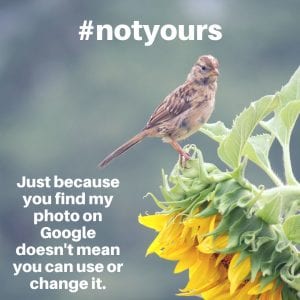(crossposted to our junior classes’ blog)
Part of the advantage of blogging in relation to other forms of writing is the ability to use images to support our message and make our content more visual. People understand us better when we use pictures and other media, because then they’re getting the information in a variety of different ways. Besides – well-chosen pictures catch the eye much as a well-chosen hook catches our attention when we start to read.

Unfortunately, when it comes to using images in our posts, novice bloggers often end up stealing from other people. Google is great to help you find images, but just because it is on Google doesn’t mean you can use it. Much like plagiarism is an offence to those who create a piece of writing, posting images that don’t belong to you without permission (and permission is not the same as merely showing where you got the photo) is an intellectual offence. If you’ve put your time and effort into creating or taking amazing images, it’s incredibly frustrating to see them pop up all over the internet without your permission or attribution (what it’s called when you say who created or took the image).
In short, unless it is stated otherwise, everything you find on the internet is covered by copyright, and you can’t use it without permission. (For some of you, that means you’re going to need to find a new avatar picture.)
Some artists, however, will share their work with other people by putting it under a Creative Commons license. There are different kinds. In simplified terms, from most to least permissive:
- The CC0 licence places the media in the public domain, which means that it can be used, changed, or remixed without any restrictions.
- The “Attribution” licence (CC BY) allows you to use, change and remix media, even for profit, if you identify its original creator.
- The “Attribution-ShareAlike” license (CC BY-SA) allows you to use, change and remix media, even for profit, if you identify its original creator AND license your version with the same (CC BY-SA) Creative Commons license.
- The “Attribution-NoDerivs” license (CC BY-ND) allows you to share the media, even for profit, as long as you identify its original creator, but not change it in any way.
- The “Attribution-NonCommercial” licence (CC BY-NC) allows you to use, change and remix media, as long as it is not for profit and you identify the original creator.
- The “Attribution-NonCommercial-ShareAlike” licence (CC BY-NC-SA) allows you to use, change and remix media, as long as it is not for profit, you identify the original creator, and you licence your version with the same (CC BY-NC-SA) Creative Commons licence.
- Finally, the most restrictive Creative Commons licence is the “Attribution-NonCommercial-NoDerivs” license (CC BY-NC-ND), which allows you to share the media only if you identify the original creator and are not using it commercially for profit.
You can find Creative Commons images by using this search engine. There are also a number of different sites on which you can search for images, but you need to remember that – like when you search on Google – not all of the images are appropriate content. In addition, some of the sites have age restrictions. This week’s post on the Student Blogging Challenge blog includes links to and information about some of the best Creative Commons image search sites, as well as how to attribute the images you find. The post also includes detailed information about this week’s tasks:

For our class, you may choose any one of the tasks to complete by this Saturday evening and then submit your post URL to the challenge. In addition, if you’ve used photos or images by other people in your posts, please go back and make sure that you have permission to use them, and that you have properly attributed them. If you need to, find a Creative Commons image (or create an image yourself!) to replace a copyrighted image that you don’t have permission to use. Remember that you need to read and comment on other people’s posts, and you should be responding to the comments on your posts as well (though if there are a lot, you may only choose the most interesting ones for your replies).
